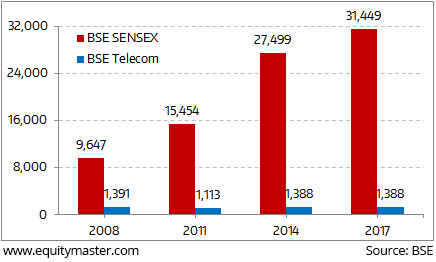After opening the day on a negative note, Indian share markets have continued the downtrend and are currently trading in red. Sectoral indices are trading mixed, with stocks in the capital goods sector and stocks in the banking sector witnessing maximum selling pressure.
The BSE Sensex is trading down by 310 points (down 0.9%) and the NSE Nifty is trading down 94 points (down 0.9%). Meanwhile, the BSE Mid Cap index is trading down by 0.6%, while the BSE Small Cap index is trading down by 0.7%. The rupee is trading at 64.11 to the US$.
In news from stocks in the telecom sector. Bharti Airtel share price is among the top gainers on the bourses today. The surge came after, the country’s largest telecom company said that Singapore Telecommunications Ltd (Singtel) will increase its stake in Bharti Airtel, by investing Rs 26.5 billion in parent Bharti Telecom.
The stake will be increased by a preferential allotment of shares to Singtel, and the proceeds will be used to reduce the debt of the company.
As of December 2017, Airtel’s consolidated debt stood at Rs 917 billion.
Singtel will be allotted up to 8.5 million equity shares at an issue price of Rs 310 per equity share.
With this investment through its wholly-owned subsidiary, Singtel’s total stake (along with its affiliates) in Bharti Telecom will increase to 48.9%, from 47.17%. Consequently, Singtel’s economic interest in Bharti Airtel will rise by 0.9% to 39.5%.The transaction, which is subject to the shareholders’ approval of Bharti Telecom, is expected to be completed by March 2018. Bharti Enterprises continues to hold over 50% stake in Bharti Telecom.
Singtel’s investment comes at a time when the telecom sector is going through a slump.
Telecom Sector: A decade of Underperformance

The whole telecom business has been an underwhelming story so far. While the telecom subscriber base has increased from 300 million in 2008 to 1.2 billion in 2017, investors have little to cheer. The BSE Sensex has gone up 3.25 times in nine years, but the BSE Telecom Index has not moved an inch from its levels of 2008.
With the entry of Reliance Jio, the competition has intensified further. Reliance Jio’s low cost offerings and strategy of capturing market share will further dent the sector. The sector has been a classic ‘value trap’. While it always looks cheap compared to other sectors, it has failed to provide any reasonable returns. We also believe the situation is unlikely to change in the near future. For an investor, it’s important to differentiate between ‘value’ and ‘value traps’.
At the time of writing, Bharti Airtel share price was trading up by 4.4%.
Moving on to news from stocks in the automobile sector. Mahindra & Mahindra (M&M) share price is in focus today after the management has shown interest in developing new electric vehicles.
According to a leading financial daily, M&M has sought board approval to invest about Rs 8 billion to develop two new electric vehicle (EV) products and set up a research and development Centre for such vehicles.
M&M, which has so far invested Rs 6 billion in its electric venture, plans to raise EV capacity to 1000 units a month by end-2018 from about 200 units now, and 5,000 by 2020. If everything goes as planned, M&M could be selling 60,000 EVs annually by 2020, and if that makes up a quarter of the market, that would mean a total EV market size of 250,000.
Currently, electric vehicle sales are low in India, rising 37.5% to 22,000 units in the year ended 31 March 2016 from 16,000 in 2014–15. Only 2,000 of these were cars and other four-wheelers, according to automobile lobby group Society of Indian Automobile Manufacturers (Siam).
The government wants to see 6 million electric and hybrid vehicles on Indian roads by 2020 under the National Electric Mobility Mission Plan 2020.
The government is targeting to have all cars propelled by electric engine by 2030. The target is more daunting than in many advanced countries.
According to the industry, the 2030 target would require eight to ten times the global stock of such vehicles. India would need to sell more than 10 million electric cars in 2030, compared to 5,000 electric vehicles India had on the road in 2016.
Another issue is the price of the lithium ion battery, which constitutes 30% to 40% of the cost of the car. For this plan to succeed, the price of the battery needs to come down.
The auto industry is already facing regulatory headwinds. The shift from BS-IV emission norms to BS-VI has been two years ahead of schedule without an intermediate stage. The government, if it is serious about such ambitious targets, should offer the necessary infrastructure support and do its bit for a smooth transition.
At the time of writing, M&M share price was trading down by 1%.
This article was originally published in English at www.equitymaster.com
Read the complete Indian stock market update. For the terms of use, go here.
No comments:
Post a Comment